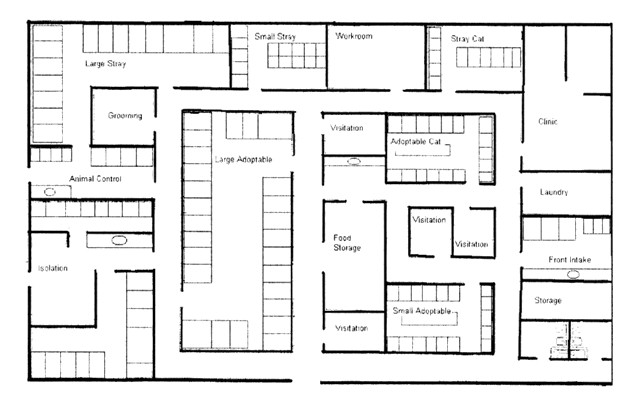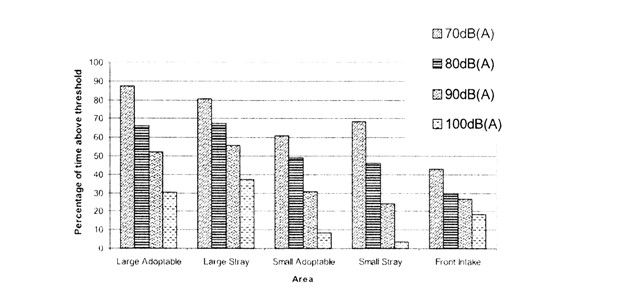
FIGURE 1: Diagram ofthe humane society (66 ft x 120 ft)
R. Mark Enns and Temple Grandin
Animal Sciences Department
Colorado State University
JOURNAL OF APPLIED ANIMAL WELFARE SCIENCE, 9(l), 1-7
Sound levels in animal shelters regularly exceed 100 dB. Noise is a physical stressor on animals that can lead to behavioral, physiological, and anatomical responses. There are currently no policies regulating noise levels in dog kennels. The objective of this study was to evaluate the noise levels dogs are exposed to in an animal shelter on a continuous basis and to determine the need, if any, for noise regulations. Noise levels at a newly constructed animal shelter were measured using a noise dosimeter in all indoor dog-holding areas. These holding areas included large dog adoptable, large dog stray, small dog adoptable, small dog stray, and front intake. The noise level was highest in the large adoptable area. Sound from the large adoptable area affected some of the noise measurements for the other rooms. Peak noise levels regularly exceeded the measuring capability of the dosimeter (118.9 dBA). Often, in new facility design, there is little attention paid to noise abatement, despite the evidence that noise causes physical and psychological stress on dogs. To meet their behavioral and physical needs, kennel design should also address optimal sound range.
Noise in an animal shelter has previously been discussed (Key, 2000; Milligan, Sales,& Khirnykh, 1993; Sales, Hubrecht, Peyvandi, Milligan, & Shield, 1997). Sales et al. reported that sound levels regularly exceeded 100 dB. Sound is measured in decibels (dB) and the scale is logarithmic, meaning that 90 dB is 10 times the intensity of 80 dB and is 100 times the intensity of 70 dB. A noise level over 70 dB(A) is considered "loud" (Baker, 1998). To put this into context, 95 dB(A) is comparable to a subway train, 110 dB(A) is a jackhammer, and 120 dB(A) is a propeller aircraft; any sound in the 90 to 120 dB(A) range is considered to be in the critical zone and can be felt as well as heard (Key, 2000). No single method or process exists for measuring occupational noise. A noise dosimeter is preferred for measuring noise levels when the noise levels are varying or intermittent and when they contain impulsive components such as barking. One consideration when using a noise dosimeter is that the microphone is within the hearing zone of individuals being monitored.
It has long been documented that audible sound has profound physiological and psychological effects on nonhuman animals and disturbs the healthy equilibrium of the body (Wei, 1969). Noise has been found to be a physical stressor on animals that can lead to behavioral, physiological, and anatomical responses. Noise-induced cortisol increases can cause immunosuppression, insulin resistance, cardiovascular diseases, catabolism (molecular decomposition), and intestinal problems (Spreng, 2000). The hearing of animals differs from that of humans; dogs (Canis familiaris) have much better hearing and can hear sounds up to four times quieter than can the human ear. Recent research shows that noise in dog kennels may be a welfare concern for the animals (Sales et al., 1997), but currently no policies regulate noise levels in dog kennels.
The objective of this observational case study was to evaluate the levels of noise to which dogs are exposed on a continuous basis and to determine the need for noise regulations. Regulations may emphasize the necessity to control levels through building design and materials instead of trying to reduce the noise produced by the animals. The facility where this study was conducted was designed and built in the last 7 years. However, as is often typical, there were no obvious preventative measures in the design to reduce noise and, in fact, design may have had the opposite effect due to animal arrangement, the use of concrete block, and exposed metal roofing.

FIGURE 1: Diagram ofthe humane society (66 ft x 120 ft)
The large adoptable and large stray areas are constructed of epoxy-painted cinder block walls and seamless floors on a concrete slab. The dog runs in the large adoptable and the large stray areas are separated by cement partitions (82 in.) and have chain link doors. Both of these areas have an exposed steel ceiling (> 20 ft), Noise dosimeters were mounted on the wall in these rooms at a height of 12 ft.
The large adoptable area is a smaller area within a larger area enclosed by a cement perimeter wall (82 in.). The larger room is connected by two hallways, eight doors to other areas (including large stray and small adoptable), and one exterior door. This area contains 26 runs with Plexiglas view windows on one end. The dog kennels line all four perimeter walls. There is an employee work area (food preparation, washing dishes) in the middle of the room. The large stray area is a separate room adjacent to the large adoptable area. This area has two doors and contains 15 kennels. The dog kennels line the south and east walls.
The small adoptable, small stray, and front intake areas are all separate rooms with a suspended nonacoustical tile ceiling (8 ft) and plasterboard walls. Noise dosimeters were mounted on the wall in these rooms at a height of approximately 7 ft.
The small adoptable and small stray areas each have one door, a concrete slab floor, and contain metal cages. The cages in the small adoptable area face the interior of the room and the exterior has Plexiglas windows; there is an employee work area in the middle of the room. The cages in the small stray area line the cast wall and are also placed down the middle of the room. The front intake area contains cages and runs separated by sheet metal (60") and a linoleum floor. All kennels and cages are on the south wall. The room also has a refrigerator and a counter in each area with a sink and cabinets. The number of kennels and average number of animals during the study period are summarized in Table 1.
| Holding Area | Average No. of Animals | No. of Kennels | Areaa |
|---|---|---|---|
| Large adoptable | 34.25 dogs | 26 runs | 880 |
| Large stray | 15 dogs | 15 runs | 485 |
| Small adoptable | 9.8 dogs | 28 cages | 285 |
| Small stray | 9 dogs | 17 cages | 258 |
| Front intake | 4 dogs, 9.75 cats | 4 runs, 4 cages | 240 |
a Given in square feet.

FIGURE 2: Percentage of time during the study period above each threshold level (70, 80, 90, and 100 dBA) for large adoptable, large stray, small adoptable, small stray, and front intake areas.
The animals' mental and physical states are compromised; the employees may develop hearing damage and poor states of mind in caring for the animals. Our observations indicate that visitors sometimes are so bothered by the noise that visiting time is reduced during their search for an animal to adopt.
The large adoptable area is designed so that every dog can see every other dog if the dogs are at their kennel doors. The work area for this room also is located in the center of the rectangle, making it an additional source of stimulation. We observed that this layout allows for constant stimulation and may increase barking, as any activity within the large adoptable area stimulates every dog in the area. The result is virtually constant barking.
The design and building materials used do not allow for noise absorption, with the exception of rooms with suspended ceilings (small stray, small adoptable, and front intake). These do allow for absorption and somewhat reduced noise levels, although this difference was not statistically significant. The current public viewing design also contributes to the amount of stimulation for the dogs. The viewing windows start half-way up the perimeter wall. The placement of the viewing windows and the use of partitions between every kennel results in dogs that are constantly being surprised by people walking by and abruptly coming into view.
In the shelter environment, cortisol levels have been documented to be above normal, in some cases three times that of household pets (Hennessey, Davis, Williams, Mellott, & Douglas, 1997). We also found that in this instance (Coppola, Grandin, & Enns, 2006). Not all stress-induced elevations in cortisol are due to noise levels, but they are a contributing factor.
An increasingly popular way to design dog housing is to have self-contained rooms instead of the traditional kennels or runs. These rooms are typically enclosed within a larger area either with or without a community play area attached. Noise is absorbed and contained within the smaller room. These designs may also permit social housing of dogs, which research has shown to decrease noise caused by animal vocalization and increase the time animals spend sleeping (Hetts, Clark, Calpin, Arnold, & Mateo, 1992; Mertens & Unshelm, 1996). The incorporation of areas for play groups can contribute to noise abatement, as a mentally and physically exercised dog usually is a quiet one (personal communication, November 17, 2005; San Francisco Society for the Prevention of Cruelty to Animals, American Society for the Prevention of Cruelty to Animals, Humane Society at Lollypop Farm, Denver Dumb Friends League, North Shore Animal League). The American Society for the Prevention of Cruelty to Animals in New York has recently renovated both its holding and adoption areas to embrace these concepts and the San Francisco Society for the Prevention of Cruelty to Animals has been housing their adoptable dogs in "apartment-style" quarters since 1998.
Coppola, C. L., Grandin, T., & Enns, R. M. (2006). Human interaction and cortisol: Can human contact reduce stress for shelter dogs? Physiology & Behavior, 87, 537-541.
Hennessy, M. B., Davis, H. N., Williams, M. T., Mellott, C., & Douglas, C. W. (1997). Plasma cortisol levels of dogs at a county animal shelter. Phvsiology & Behavior, 62, 485-90.
Hetts, S., Clark. J. D., Calpin, J. P., Arnold. C. E., & Mateo, J. M. (1992). Influence of housing conditions on beagle behaviour. Applied Aninial Behaviour Science, 34, 137-155.
Key, D. (2000). Acoustic measures. Retrieved July 1, 2003, from http://www.kenneldesign.com.
Mertens, P. A., & Unshelm, J. ( 1996). Effects of group and individual housing on the behavior of kennelled dogs in animal shelters. Anthrozoos, 9(l), 40-5 1.
Milligan, S. R., Sales, G. D., & Khirnykh, K. (1993). Sound levels in rooms housing, laboratory animals: An uncontrollable daily variable. Physiology and Behavior, 53, 1067-1076.
Sales. G. D., Hubrecht, R., Peyvandi, A.. Milligan, S., & Shield, B. (1996). Noise in dog kennelling: A survey of noise levels and the causes of noise in animal shelters, training establishments and research institutions. Wheathampstead, Hertsfordshire, England: Universities Federation for Animal Welfare.
Sales, G. D., Hubrecht, R., Peyvandi, A., Milligan, S., & Shield, B. (1997). Noise in dog kennelling: Is barking a welfare problem for dogs? Applied Animal Behaviour Science, 52. 321-329.
Sales. G. D., Milligan, S. R., & Khimykh. K. (1993). The acoustic environment and its effects on laboratory animals, Fifth FELASA Sympositan: Welfare and Science, 60-64.
SAS Institute Inc. (2002). SAS Version 8 (Version 2002). Computer software. Cary, NC: Author.
Spreng, M. (2000). Possible health effects of noise induced cortisol increase. Noise & Health, 7, 59-63.
Wei, B. L. (1969). Physiological effects of audible sound. AAAS Symposium Science, 166(3904), 533-535.
 Click here to return to the Homepage for more information on animal behavior, welfare, and care.
Click here to return to the Homepage for more information on animal behavior, welfare, and care.